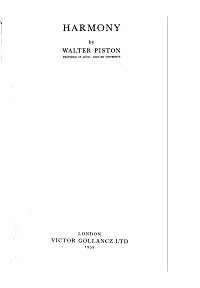|
Walter Piston - Harmony (1959) |
Walter Piston - Harmony (1959)
Walter Piston - Harmony (1959). You can download the PDF sheet music Walter Piston - Harmony (1959) on this page. The aim of this book is to present as concisely as possible the harmonic common practice of composers of the eighteenth and nineteenth centuries. Rules are announced as observations reported, without attempt at their justification on aesthetic grounds or as laws of nature. The written exercises should be performed as exemplifications of the common practice of composers and not as efforts in creative composition. The author believes that through these principles a prompt and logical grasp of the subject will be achieved.
To download PDF, click the "Download PDF" button below the appropriate sheet music image.
To view the first page of Walter Piston - Harmony (1959) click the music sheet image. |
| PDF format |
|
|
|
Book: 350 pages. 120082 K
|
|
 |
|
|
|
| Download PDF (14.99
€) |
|
|
|
The first important step in the study of harmony is that of clarifying the purpose of such study. Much confusion exists today as to why we study musical theory and what we should expect to learn from it. In the present writer's teaching experience this confusion of outlook furnishes the commonest and most serious obstacle to progress in all branches of musical theory.
There are those who consider that studies in harmony, counterpoint, and fugue are the exclusive province of the intended composer. But if we reflect that theory must follow practice, rarely preceding it except by chance, we must realize that musical theory is not a set of directions for composing music. It is rather the collected and systematized deductions gathered by observing the practice of composers over a long time, and it attempts to set forth what is or has been their common practice. It tells not how music will be written in the future, but how music has been written in the past.
The results of such a definition of the true nature of musical theory are many and important. First of all, it is clear that this knowledge is indispensable to musicians in all fields of the art, whether they be composers, performers, conductors, critics, teachers, or musicologists. Indeed, a secure grounding in theory is even more a necessity to the musical scholar than to the composer, since it forms the basis for any intelligent appraisal of individual styles of the past or present.
In the specific field of harmony we must first seek the answer to two questions—what are the harmonic materials commonly used by composers, and how have these materials been used? We cannot afford in the first stages of our study to become interested in the individual composer at the expense of concentration on establishing the norm of common practice. With such a norm firmly in mind, the way will be clear to the investigation of the individual harmonic practices of composers of all periods, and especially to the scientific examination of the divergent practices noticeable in the twentieth century.
Historically, the period in which this common practice may be detected includes roughly the eighteenth and nineteenth centuries. During that time there is surprisingly little change in the harmonic materials used and in the manner of their use. The experimental period of the early twentieth century will appear far less revolutionary when the lines of development from the practice of older composers become clearer by familiarity with the music. As yet, however, one cannot define a twentieth century common practice. |
|